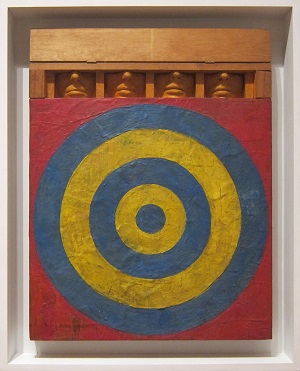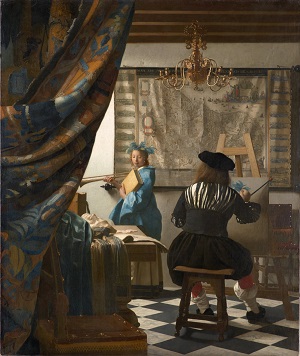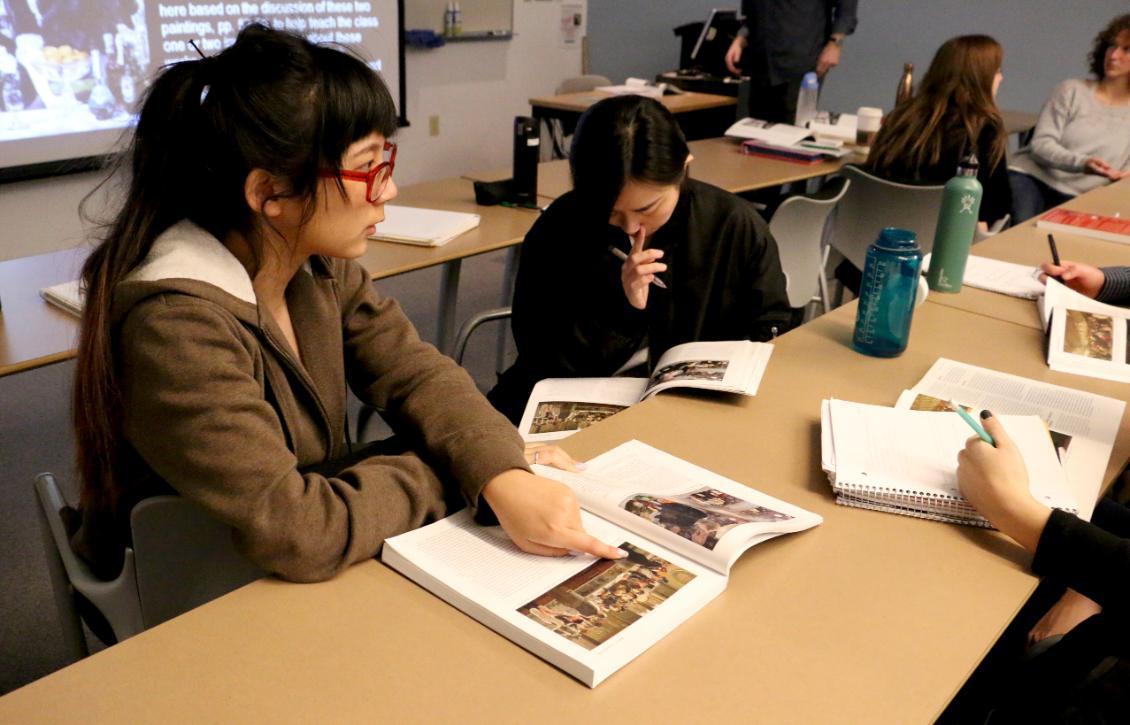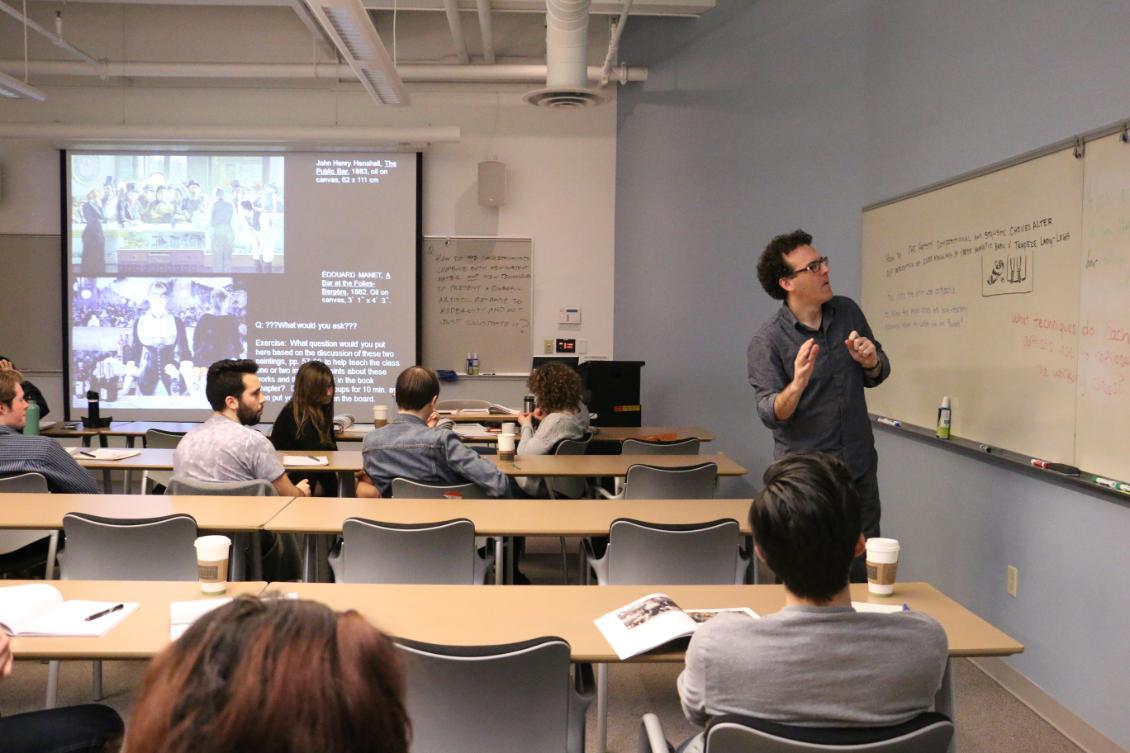
Featured Navigation Links
Degrees & Minors
Faculty & Staff
Innovative Programs
Classrooms & Galleries
Student Work
Alumni
Art & Visual Culture Studies

Laura Stowell, BA ('14)
“The smaller, seminar-based classes and how our paper topics were often flexible and open to our own interests allowed me to get deeper into material that interested me and helped prepare me for graduate study.”

Jasmine Magaña, BA ('11)
"I rely heavily on my art historical training to identify connections between historical and contemporary artworks and movements so that I can more easily put the works into productive dialogue.”
Art History, BA
Program Summary
Art History at Seattle U explores how art and visual culture shape the ways we see history. How does an art object reveal ideas about a culture differently than a text or document? Students learn to visually analyze and write about art using Seattle’s museums and galleries and to integrate these encounters with their critical study of scholarship from a variety of perspectives.
Recent courses include: Robots, Machines and the Body in Avant-Garde Art, Latin American Baroque Art, and Art and Place in the American West
As an Art History student you will investigate the history of art and visual culture to understand the original meaning of works of art and make connections to current concerns. Across a range of periods and societies, you will explore the materials, techniques and presentation strategies that artists and makers employ in their work. Your courses will include visits to local museums and public art sites, gallery talks by curators, and guest lectures by artists and scholars. Students may also take elective courses in Visual Art, Photography or Design.
Learning Outcomes:
Art History students should be able to:
- Articulate histories of visual production and think critically about the stakes of artistic creation by interpreting works of art both as formal structures and in relation to social and cultural contexts.
- Write convincingly about works of art using composite evidence (visual, historical, and textual) that relies upon primary and secondary textual sources and works of art in public exhibition.
- Demonstrate analytical and communication skills by delivering oral presentations about an art historical question modeled on those for a public or scholarly setting.
- Evaluate and critique a variety of methodological approaches employed within the discipline in a project that will lead to an original conception of an art historical problem in a major research paper.

ARTH 4620-01: Space and Site in Contemporary Art
An in-depth investigation of the emergence of art practices based on the viewer’s participation and interaction with the art work as part of an installation, environment or experience. Focuses on art since the 1960s by exploring the relationships between the art object and the spaces and sites of display in relation to theories of space and place, postmodernism, globalization and the everyday. Students give a creative oral presentation on a series of Seattle sites of their choosing as a mid-term project. Final project will be a short research paper (10-12 pages) and presentation on an artist/artwork of the student’s choosing. Field trips and guest artist lectures are included in this course.

ARTH 3510-01 Trauma, Image, Text: History & Representation after WWII
Does art matter in a world full of political conflict, human suffering, and social and economic inequality? After the cataclysm of world war and the Holocaust is making art even a responsible thing to do? These were questions that faced artists and intellectuals in the latter half of the 20th century. "Trauma, Image, Text" considers the relationship between history and its representation in select moments from the 1940s to today. Can art adequately portray the traumatic reality of history and how have artists and writers struggled with this question in forms as diverse as film, painting, poetry, the novel, criticism and video?

ARTH 3500: Art since 1945: Foundations of Contemporary Art & Criticism
What makes art “contemporary” and how did the idea of the artist change after WWII with the rise of consumerism, electronic media, celebrity culture and the art market? This is a survey of the ideas that made particular ways of making art matter in the United States from 1945 to the present. Students explore questions such as: Why did Jackson Pollock drip paint on his canvas in the 1950s? What was Robert Smithson doing putting rocks in the Great Salt Lake in 1970? Why were Kara Walker’s 19th c. silhouettes depicting racial violence pasted to museum walls controversial in the 1990s? Why did Mark Dion take a log from the Olympic Peninsula and put it in a greenhouse on Seattle’s waterfront in 2005?

ARTH 2120: The Status of the Artist
In this introductory art history course, students explore art from the Renaissance to the 20th c. by asking questions such as: Why did Renaissance artists argue that they were intellectuals rather than artisans? Why did modern artists then attack the intellectual traditions of art to demand social change and radically question the purpose art itself? You will look for answers to these questions by discussing topics such as: symbols of the liberal arts in 16th c. paintings, female artists’ self-portraits in the Renaissance, gender as a central anxiety in depictions of modern Paris, 19th c. paintings of the working class, and the Dada artists’ absurd responses to WWI.
-
Honors
-
Honors in Art History
Art History Honors projects usually take the form of an extended research paper on a specific topic developed by the student in consultation with a faculty advisor. The Honors project proposal is due October 15th of the student's senior year. Students interested in developing honors projects should contact a faculty member to begin discussions about the proposal in spring quarter of their junior year. Art History students often present work at the National Conference for Undergraduate Research. Honors Students gain valuable experience by presenting a 20 minute talk on their projects on campus.
Past topics have included:
- “Feminist Theory, Institutional Critique, and the Reconceptualization of Museum Identity” (Carey Stangl, ’17)
- “Buster Simpson and the Art of Urban Activism” (Megan Moran ’14)
- “Visceral Engagement and the Sculpture of Kienholz and Hesse” (Michelle Sizemore ’09)
-
Opportunities
-
Opportunities:
Student and Faculty Trip to Los Angeles, funded by the Pigott Family Endowment for the Arts:
 On a three-day trip to the city of Los Angeles, selected students get an opportunity to see different aspects of a major international art center. Students meet artists and see work in progress in their studios, talk with curators of small, non-profit art spaces as well as see influential art of the past and present in exhibitions at major museums. Faculty such as Ken Allan (art history) and Franc Guerrero (Visual Art) lead discussions that help students connect their studies and art practices to the histories and current debates that animate the global contemporary art world.
On a three-day trip to the city of Los Angeles, selected students get an opportunity to see different aspects of a major international art center. Students meet artists and see work in progress in their studios, talk with curators of small, non-profit art spaces as well as see influential art of the past and present in exhibitions at major museums. Faculty such as Ken Allan (art history) and Franc Guerrero (Visual Art) lead discussions that help students connect their studies and art practices to the histories and current debates that animate the global contemporary art world. 
Students visit the Museum of Jurassic Technology in Los Angeles, a museum about museums, and a contemporary artist studio.
-
After Graduation
-
After Graduation
Students have gone on to graduate study in art history and museum studies, and received Fulbright awards for study overseas. Recent acceptances in MA and PhD programs: American University, New York University, Georgetown University, School of the Art Institute Chicago, Duke University, University of Washington, University of York, UK, University of Essex, UK.
In addition to becoming art historians, graduates have also used their degrees to become museum curators, educators, event programmers, art writers, cultural critics, auction house professionals at Christie's and Sotheby's, non profit arts leaders, and grant writers, among other things.
Ready to Transfer to SU?
-

Top 15% Highest Paid
Fine Art Graduates

